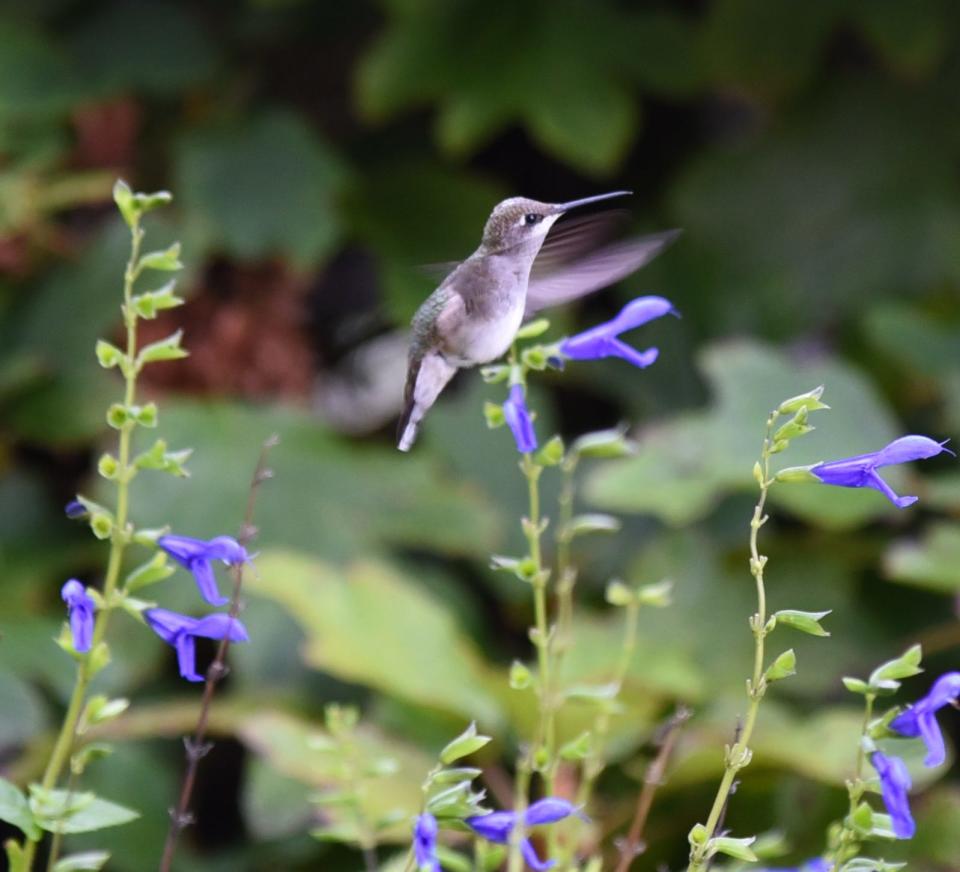Betty Montgomery: Make your garden a hummingbird hangout

What can be more magical than to watch a hummingbird, that appear to be suspended in mid-air, dip its long beak into a flower in search of nectar? I am mesmerized watching them, often hearing them before I actually see them buzzing about. We have a particular plant that I plant each year so that my husband and I can attract them to the garden by our patio. We watch as two or more of them, swoop and dive in a series of aggressive moves, as they try to protect their territory, making a chattering sound as they fly about.
Many hummingbirds spend their winters in Central America or Mexico and migrate north to their breeding grounds. They fly by day, stopping along the way for the nectar they need to continue on their journey. They are the smallest migrating bird and they do not migrate in flocks as other species. They typically travel alone.
As hummingbirds make their annual migration north, make sure your garden has some of the annuals, perennials, shrubs and vines that will attract them to your garden. These plants will add a vibrance to your garden as well as giving these cute little fellows the nectar they want and need. They are big eaters, eating over twice their weight every day. Their diet consists of both nectar and flying insects.
In planning your garden this summer, add a few of their favorite flowers so that they are attracted to your garden. These energetic and birds love a variety of flowers and the flowers that attract them the most have three things in common. Their blooms are tub-shaped (which holds more nectar), brightly colored, and they grow where it is easy for hummingbirds to hover and sip.
Most things you read say that red is their favorite color flower. I am sure you have noticed that among hummingbird feeders, red is the color of most of them for sale. They do tend to go to red flowers like, Cardinal flowers, crocosmia, salvia, beebalm, red columbine, and red daylilies but they like other brightly colored flowers too. Other flowers that they like include phlox paniculata, catmint, petunias, trumpet vine, columbine, honeysuckle, kniphofia, lavender, hollyhocks, blue salvia, and butterfly bush, most of which are summer blooming favorites.

Hummingbird’s nest and perch on the branches of taller trees and shrubs, typically 10 to 20 feet above the ground. I often see them perched on tiny twigs on trees so it is helpful to provide trees near your garden to protect them from predators. While hummingbirds are known for their fondness for nectar, they also eat a large quantity of insects, including spiders.
In my garden, I plant salvia guarantica each year in several places to attract them. This plant, a perennial in some places, will not winter over in my garden except in one place. We have a south facing azalea bed located by a brick walk that is sheltered from the cold winds. The warmth of the bricks holds enough heat to keep some plants alive all winter. They do go dormant but the roots stay alive. Then, when I see the salvia popping its heads up, I dig some out and pot it up and let it grow a little and then I plant it in a bed where we can watch the hummingbirds all summer long. ‘Black and Blue’ salvia is readily available in garden centers and it is similar in habit to the variety I have. Both grow fast and produce a plethora of blooms.

These little flying acrobats, are drawn to this plant in my garden more than any other plant. You can see them enjoying the nectar. You can hear the chattering as they chase other hummingbirds away who have also come to enjoy this particular flower. It can be quite entertaining to watch them as they swoop and dive in a series of aggressive maneuvers. However, this is not the only flower they like, but I can always count on seeing them enjoying it. This is a later blooming plant so I have to have a number of other plants to tide them over.
Cardinal flower (Lobelia) is another flower that I grow that they love. Named for the red robes worn by Roman Catholic cardinals, these flowers like a moist location and it helps to mulch to protect its root system. Bee Balm (Monarda) is another plant that attracts them, growing up to 4 feet in full sun, this plant needs some sun and moist soil. The flowers of Hosta are also attractive to them.
Hummingbirds get their name from the humming noise that occurs when they flap their wings very fast. The over 300 species of hummingbirds are native to North and South America.
The Rufous hummingbird has the longest migration, flying as much as 3,000 miles from Alaska to Mexico. The Ruby-Throated hummingbird also has a long migration route which includes the incredible task of flying 500 miles nonstop across the Gulf of Mexico! And, don’t worry, hummingbirds usually return to the same feeding ground each year.
I do love watching them dart about and I hope that I will always have flowers planted to attract these vibrantly-colored birds, inviting them to visit us each year.
Betty Montgomery is a master gardener and author of “Hydrangeas: How To Grow, Cultivate & Enjoy,” and “A Four-Season Southern Garden.” She can be reached at bmontgomery40@gmail.com.

This article originally appeared on Herald-Journal: Make your garden a hummingbird hangout

